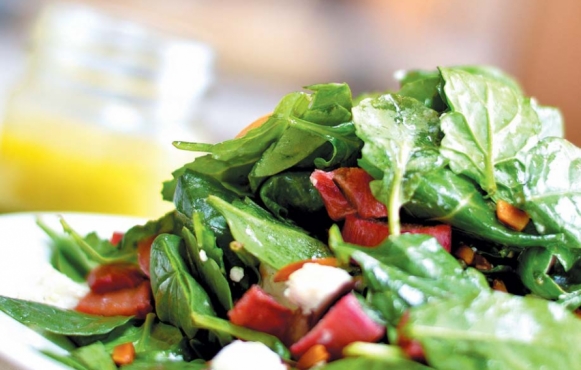Spring Salads with Chef Terri
Spring into the season with a salad.
Edible Door archives 2017 refreshed for launch of edibleNEW 2024 premiere issue
With the advent of spring, the thoughts bouncing around my culinary brain drift to one thing – fresh produce. Gone are long, dreary winter days, icy streets that mimic an ice skating rink and that Midwestern mix of rain, snow and sleet that makes driving challenging if not downright impossible.
Kickstart your spring cooking by using some of the first produce of the season to create a big, beautiful bowl of salad. Light, fresh and visually stunning, a perfectly prepared spring salad is a great way to welcome spring while incorporating nutrient-dense foods into your diet.
A simple salad of freshly picked greens tossed with a simple vinaigrette is always satisfying. But this spring, try expanding your salad-making experience by combining different flavor combinations and preparations to heighten your “salad experience.”
EXPAND YOUR GREENS VOCABULARY
First things first. It’s time to expand your greens vocabulary. It seems like every food magazine is touting a new recipe featuring kale. Even McDonald’s has joined the kale bandwagon with the addition of its kale Caesar salad.
Though kale may be the current hearty green superstar, there’s a garden full of other delicious greens waiting to find their way into your kitchen. Try adding some spicy arugula (also known as rocket) into your salad mix along with delicate yet flavorful watercress greens. For color, add red lettuces like new fire red, redina and red sails to your salad bowl.
For sturdier lettuces, look no further than the chicory family. A wide and varied group, chicories include Belgium endive, radicchio, frisee, escarole and curly escarole (also known as curly endive). Closely related to lettuces, chicories have a heartier leaf with a slightly bitter taste.
Escarole is a chicory found in most grocery stores and farmers markets. Common escarole has a broad flat leaf with a lighter yellow-green color at the base. The greens are often added to Italian soups and stews. Curly leaf escarole has a feathery edge but is a heartier leaf than its cousin frisee. Escarole can stand up to some heat, with the curly leaf variety lending itself best to a wilted salad. Try giving the cleaned leaves a quick warm-up with a little extra-virgin olive oil in a hot grill or sauté pan. The result is a slightly warmed and nutty-flavored leaf just waiting to be added to a salad.
Add quinoa for extra protein along with toasted walnuts for crunch. Finish with a simple Dijon vinaigrette dressing and some colorful spring radishes.
ROAST SOME RHUBARB
Along with lettuce, rhubarb is one of the first spring produce items to welcome in spring. A sure sign of the season is the first sighting of rhubarb stalks, pushing out of the earth like a knotty ball.
Most often used for pies, rhubarb can also be a delicious and surprising addition to a spring salad. Toss freshly cut rhubarb pieces with locally-produced honey and roast briefly in a 400-degree oven. The result is slightly sweet, slightly tart rosy-colored gems just waiting to be added to spring greens.
I like to toss this easy-to-make spring salad with my favorite “go to” vinaigrette. Made with fresh lemon juice, a touch of honey and extra-virgin olive oil, my lemon vinaigrette is quick to prepare and keeps for several weeks in the refrigerator. For visual step-by-step instructions to prepare the roasted rhubarb salad, view my rhubarb salad video with the recipe.
LEAF TO ROOT
Spring also brings us Earth Day. As a chef, the day marks an annual reminder to make a concentrated effort to use all the elements of the food I prepare.
Beets are a perfect “use it all” vegetable. The colorful beetroot bulb can be served raw, sautéed or roasted. The top greens can be steamed or sautéed, similar to kale. Plus, the many beet varieties, with their interesting names like merlin, red ace, chioggia and yellow Detroit, splash a rainbow of color to any dish.
It was the greens of the beetroot plant that were originally consumed. The beetroot was used mainly for medicinal and cosmetic purposes. Ever think of the origins of the phrase “red as a beet?” The ruby-red beetroot juice was used as dye and as a beauty product to stain lips and color cheeks.
The sweet red beetroot that we know today wasn’t cultivated as a food until the 1500s. Napoleon is credited for bringing the root main stream by declaring that beets be used as a primary source of sugar after the British restricted access to sugar cane.
Beets are high in immune-boosting vitamins A, B and C, fiber and folic acid. Whatever variety of beets you buy, purchase them with the greens attached. You’ll get two vegetables for the price of one. Beet greens are equally, if not more, nutritious than beetroot. The hearty leaves are full of nutrients that strengthen the immune system, support brain and bone health and provide a good source of beta-carotene and iron.
Thoroughly wash the leaves, then cut into ½-inch-wide ribbons. A quick blanch of the leaves in boiling water for 30 seconds followed by a rinse in a strainer under cool tap water helps lock in the nutrients and vibrant green color.
Make a warm salad of beet greens and place them on top of sliced roasted beetroot for a colorful and nutritious presentation. A perfect spring “eat everything” salad and a fitting tribute to Earth Day.







